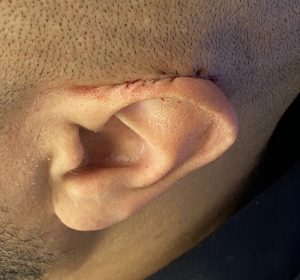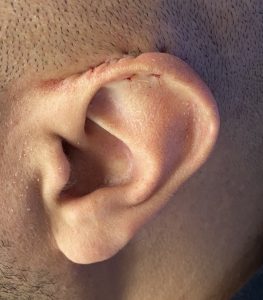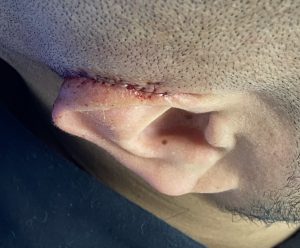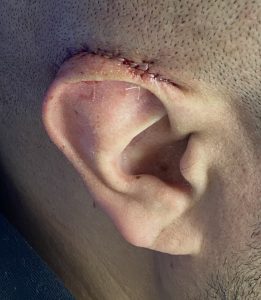Background: The ear has a very complex shape but is best appreciated when it is not easily seen. The best looking ears are often those who don’t stand out and just blend into the side of the head. How easily the ear is seen is significantly influenced by how much it protrudes from the side of the head in which a specific angular relationship exists known as the auriculocephalic angle. A normal auriculocephalic angle is in the range of 25 to 30 degrees. The closer the ear is to the side of the head the less the angle is, the more the ear sticks out the greater the angle becomes.
The most common aesthetic ear reshaping surgery is the setback otoplasty. It is specifically designed to reduce the auriculocephalic angle in the protruding ear by various cartilage reshaping techniques. It is a highly successful procedure of which the most common complication is an ear that has been setback too far with an overly decreased auriculocephalic angle. Surgeons are usually focused on avoiding overcorrection as it is more challenging to treat than undercorrection.
How much ear protrusion is considered aesthetically excessive can be open to interpretation. Such is the case in the male who shaves its head. With a flat and fully exposed side of the head (no hair) even normal auriculocephalic angles of the ear may be perceived as excessive. The ear takes on a greater aesthetic value when it is completely isolated by surrounding smooth skin.
Case Study: This shaved head made desired to have the top of his ear closer to the side of his head. His natural auriculocephalic angle at the conceal level of the ear was fairly narrow but it was the upper ear that stuck out. Its auriculocephalic angle may have been normal but compared to that of the central ear it was greater.


Setting back the upper ear with a traditional approach of using cartilage bending/folding sutures does not work well in the upper ear with a normal auriculocephalic angle. This will only create an unnatural bend to the upper ear and disrupt the smooth outline of the helical rim. Reduction of some portion of the postauricular sulcus is needed to pull the ear in This is not a cartilage shape issue but a sulcus issue. In more ‘extreme’ upper ear setbacks, as in this case, much of the sulcus was eliminated to achieve the ear setback effect that he desired. In doing so the patient must be aware that this may effect the wearing of eyeglass wear since they use the depth of the postauricular sulcus as an anchoring area.
Case Highlights:
1) Setback of the protruding ear is defined and treated by closing down a wide open auricularephalic angle.
2) In men who shave their heads a normal auriculocephalic angle may make the ear appear that it sticks out too far.
3) Setback of the protruding but normal auriculocephalic angled ear requires obliteration of the upper ear postauricular sulcus.
Dr. Barry Eppley
Indianapolis, Indiana





